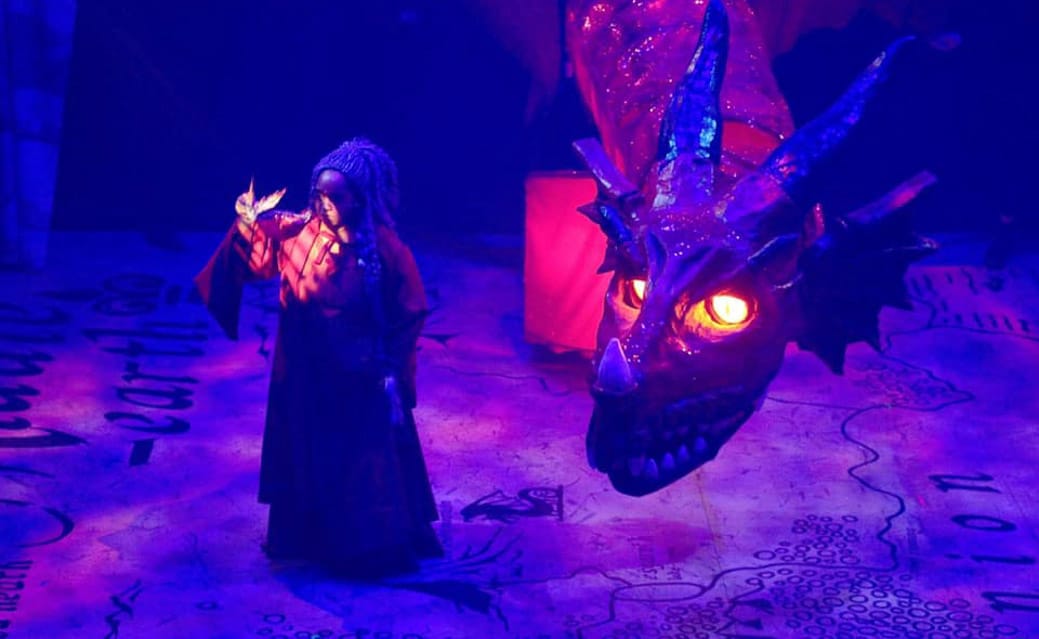Bringing Theatre to Life with Props
Theatre Erindale’s Leslie Wright shares how objects create magic within a play and reveals the struggles of adapting to a virtual stage.
For many months, the rehearsal spaces in Deerfield Hall remained closed and lightless, as students virtually rehearsed for last year’s Theatre Erindale season. Finally, in accordance with public health guidelines, some students in the Theatre Drama Studies (TDS) program are back in person and have started table reads for the first show of the season: If We Were Birds by Erin Shields. To welcome back these excited students, the Theatre Erindale staff put together window displays in Deerfield Hall that showcase some of the incredible props used in Theatre Erindale’s 2020 mainstage production of J.R.R. Tolkien’s The Hobbit.
Props are not only important for on-stage components of performance, but according to Leslie Wright, head of props and scenic paint at Theatre Erindale, they are also necessary for the creation and execution of a believable and emotionally moving piece of theatre.
“Props are [objects] that can anchor a character in a space, and they really flesh out the world of the production,” said Wright. “Having items that are meaningful to the action is important.”
Wright considers props as tools for actors and as key aspects that influence an audience’s interpretation of Theatre Erindale’s plays. Regarding The Hobbit, Wright discussed the idea that props are not always inanimate objects; props can exist as characters.
“It was really important to have some of those characters be props. Smaug the dragon, for example, I don’t think the play would have been as impactful if it was an actor and not a 16-foot-high dragon,” said Wright. “We had an actor voicing Smaug, but because we could create something that was enormous […] it just made [the play] a more real experience. Even creating the dragon and seeing it come alive was like magic, real magic. We couldn’t have achieved that with just an actor on their own.”
Wright also told The Medium about the collaboration needed to create props, especially ones as large as Smaug. Creativity is like a beast; it is often hard to tame. So, deciding when a prop is considered “done” is not always an easy process, and the team must make collective decisions before setting a stage.
“There are lots of items that you could just keep developing forever,” Wright said. “Often, [the team must] balance the workload and the needs of the particular show. We could have gone further with Smaug; at one point, we were thinking of smoke coming out of his mouth. But it was a matter of time and managing other priorities. Ultimately, if a prop serves to tell the story, if it is safe for the actors to use, and if it satisfies the artistic visions of the designer and the director, it’s done.”
After mentioning the large role props play on stage, Wright provided insight on the use and acquisition of props during Theatre Erindale’s fully virtual season last year and the challenges that came with performing online.
“Last year, we definitely did not use as many props as normal, but we still had props in our shows. We were able to do this [by] dropping [props] off to the cast,” said Wright. “It was interesting because ordinarily, with a glass [for example], we would have actors pass one glass on stage to another actor. In the case of passing [props] using Zoom, we needed two glasses—one in [each] actor’s hand. With the tricks of the camera, they passed [the glass]. That being said, we had lots of duplicates.”
Looking forward to the upcoming season at Theatre Erindale, Wright hopes that prop duplicates are a thing of the past. With the enhanced sanitization of props and all on-stage components, this year’s productions are set to take place within Erindale Studio Theatre. However, audiences will most likely have to tune in through virtual platforms.
If We Were Birds sets the stage from October 28 to November 7, 2021. Although it is not expected to be a “prop-heavy show,” Wright said that set design is already in the works, and that the excitement of the TDS students is extremely contagious. So, save the dates! You will not want to miss out on the first show broadcasted live from Erindale Studio Theatre.
Arts & Entertainment Editor (Volume 49) | arts@themedium.ca — Julia graduated in 2022 with a major in English, and a Professional Writing and Communications and Drama double minor. She previously worked with The Medium as Theatre Erindale Correspondent for Volume 48. As the A&E Editor this year, Julia cannot wait to explore the wondrous world of arts and spark creative conversations amongst student writers. If she’s not writing, working, or spending too much money on overpriced iced coffees, you can find Julia singing tunes with her guitar, bingeing Netflix shows, or going on nature walks with her doggo Benji. You can connect with Julia on LinkedIn or Instagram.


